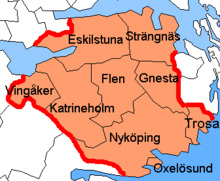Södermanland County
Södermanland County, Södermanlands län, is located within within the Svealand region in Sweden, east of Södertörn island and Södertälje, which belong to Stockholm County.
The county is an accessible part of Sweden, with the Stockholm-Skavsta airport, as well as good road and rail connections in all directions. There are many picturesque towns, palaces, and waterfront sceneries at the Baltic Sea and inland lakes.

Municipalities
- Nyköping - the county's capital and home to the Skavsta Airport, Sweden's third largest by passenger traffic
- Eskilstuna - Sweden's "Steel City" of 100,000 inhabitants, with an industrial reputation and wealth often compared to Sheffield, but with a rich history reaching far into medieval times
- Flen - holds the world's northernmost vineyard, the age-old market of Malmköping and a particular allure to songwriters who seemingly cannot stop referencing it in (Swedish) songs
- Gnesta - a peaceful municipality of just 10,000, used as a refuge by inhabitants of larger cities who often own summer homes there; made famous by the film The Girl with the Dragon Tattoo
- Katrineholm - not much of a tourist destinations, but rather an erstwhile industrial hub and today a sizeable commuter town
- Oxelösund - one of Sweden's smallest municipalities and most recently (only in 1951) created cities, member of the douzelage, a unique twinning of small towns across the European Union
- Strängnäs and Mariefred - the municipality of Strängnäs is best known for the former monastery of Mariefred and the Gripsholms castle which replaced it
- Trosa - a small suburb of both Nyköping and Södertälje and another popular place for summer homes and boating trips
- Vingåker - a sleepy backwater of a municipality with a museum in the estate of an erstwhile local art collector
While Södertälje, Södertörn and the southern parts of Stockholm and the Stockholm archipelago belong to the traditional Södermanland province, they are within Stockholm County, and not described by this article.
Other destinations
- Taxinge slott, Nykvarn
Understand
The Södermanland County was formed in 1634 and named after the traditional province of Södermanland, or Sörmland for short. Around that time, Stockholm has cemented its leading role and importance for Sweden, and thus it became a separate city, and the lands around it a separate county, Stockholm County, carved out of the traditional provinces of Södermanland and Uppland (the rest of latter became today's Uppsala County). This 17th-century administrative division proved so effective that it remained in place until today.
Södermanland has, through Lake Mälaren, later the railroads, and at present day the Skavsta Airport, been a gateway between inner Sweden and the outer world. The Industrial Revolution made cities such as Eskilstuna and Oxelösund flourish. Despite the cosmopolitan influences, most of Södermanland is still rural.
The Swedish dialects spoken in Södermanland, especially in Nyköping, are said to be the base of the standard Swedish language, which developed in the 19th century.
Get in
Resrobot is a search engine for all public transport inside Sweden.
By plane
- Stockholm Skavsta Airport near Nyköping. Local bus connection to Nyköping.
- Stockholm Arlanda Airport in Sigtuna, north of Stockholm. Train connection to Södermanland, often with train change in Stockholm.
By train
SJ provides long-distance trains that stop in Katrineholm (or you need a change in Norrköping), and regional trains that stop in Nyköping, Eskilstuna and Strängnäs.
By bus
Swebus have long-distance buses which stop in Nyköping.
Get around
By train
The SJ can in part used to travel inside Södermanland but they go mainly to and from Stockholm.
By bus
Länstrafiken handle the local buses. They go between settlements, and there are city buses inside the larger cities.
By foot
Most city centres are walkable.
See
- Taxinge-Näsby Castle
Do
Södermanland County is mainly quiet countryside with plenty of lakes, good for outdoor life.
Eat
Cheese from Flen.